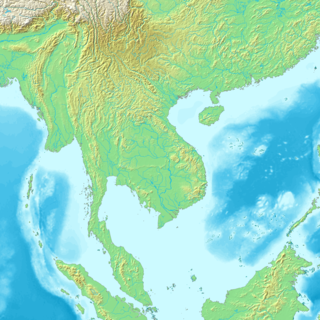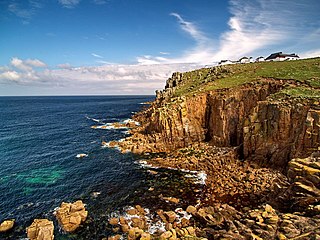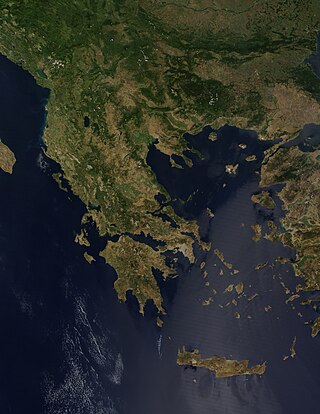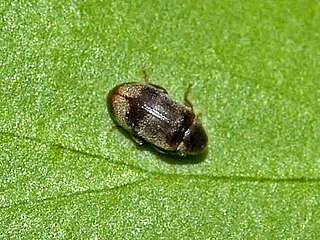
Continental Europe or mainland Europe is the contiguous mainland of Europe, excluding its surrounding islands. It can also be referred to ambiguously as the European continent, – which can conversely mean the whole of Europe – and, by some, simply as the Continent. When Eurasia is regarded as a single continent, Europe is treated both as a continent and subcontinent.

Mainland Southeast Asia is the continental portion of Southeast Asia. It lies east of the Indian subcontinent and south of Mainland China and is bordered by the Indian Ocean to the west and the Pacific Ocean to the east. It includes the countries of Cambodia, Laos, Myanmar, Thailand and Vietnam as well as Peninsular Malaysia.

The Western Hemisphere is the half of the planet Earth that lies west of the Prime Meridian—which crosses Greenwich, London, England—and east of the 180th meridian. The other half is called the Eastern Hemisphere. Geo-politically, the term Western Hemisphere is often used as a metonym for the Americas or the "New World", even though geographically the hemisphere also includes parts of other continents.

Venice Marco Polo Airport is the international airport of Venice, Italy. It is located on the mainland near the village of Tessera, a frazione of the comune of Venice located about 4.1 nautical miles east of Mestre and around the same distance north of Venice proper. Due to the importance of Venice as a leisure destination, it features flights to many European metropolitan areas as well as some partly seasonal long-haul routes to the United States, Canada, South Korea and the Middle East. The airport handled 11,184,608 passengers in 2018, making it the fourth-busiest airport in Italy. The airport is named after Marco Polo and serves as a base for Volotea, Ryanair, Wizz Air and easyJet.
Mainland is defined as "relating to or forming the main part of a country or continent, not including the islands around it [regardless of status under territorial jurisdiction by an entity]." The term is often politically, economically and/or demographically more significant than politically associated remote territories, such as exclaves or oceanic islands situated outside the continental shelf.

In geography, a sound is a smaller body of water usually connected to a sea or an ocean. A sound may be an inlet that is deeper than a bight and wider than a fjord; or a narrow sea channel or an ocean channel between two land masses, such as a strait; or also a lagoon between a barrier island and the mainland.

A landmass, or land mass, is a large region or area of land that is in one piece and not noticeably broken up by oceans. The term is often used to refer to lands surrounded by an ocean or sea, such as a continent or a large island. In the field of geology, a landmass is a defined section of continental crust extending above sea level.

Prohibitory traffic signs are used to prohibit certain types of manoeuvres or some types of traffic.

Metropolitan France, also known as European France, is the area of France which is geographically in Europe. This collective name for the European regions of France is used in everyday life in France but has no administrative meaning, with the exception of only Metropolitan France being part of the Schengen Area. Indeed, the overseas regions have exactly the same administrative status as the metropolitan regions. Metropolitan France comprises mainland France and Corsica, as well as nearby French islands in the Atlantic Ocean, the English Channel, and the Mediterranean Sea. Its borders have undergone significant changes over the centuries, particularly in the east, but have remained unaltered since 1947.

A subregion is a part of a larger geographical region or continent. Cardinal directions are commonly used to define subregions. There are many criteria for creating systems of subregions; this article is focusing on the United Nations geoscheme, which is a changing, constantly updated, UN tool based on specific political geography and demography considerations relevant in UN statistics.

Fennoscandia, or the Fennoscandian Peninsula, is a peninsula in Europe which includes the Scandinavian and Kola peninsulas, mainland Finland, and Karelia. Administratively, this roughly encompasses the mainlands of Finland, Norway and Sweden, as well as Murmansk Oblast, much of the Republic of Karelia, and parts of northern Leningrad Oblast in Russia.

Continental Portugal or mainland Portugal comprises the bulk of the Portuguese Republic, namely that part on the Iberian Peninsula and so in Continental Europe, having approximately 95% of the total population and 96.6% of the country's land. Mainland Portugal is therefore commonly called by residents of the Portuguese archipelagos of the Azores and Madeira the continent in all respects including minor elements of combined governance from Lisbon, the country's capital. Before 1975, when the Portuguese territory also stretched to several now-independent states in Africa, the designation metropolis was also used.

The Macao Special Administrative Region of the People's Republic of Chinapassport is a passport issued to Chinese citizens who are permanent residents of the Chinese Special Administrative Region of Macau.

Determining the boundaries between the continents is generally a matter of geographical convention. Several slightly different conventions are in use. The number of continents is most commonly considered seven but may range as low as four when Afro-Eurasia and the Americas are both considered as single continents. An island can be considered to be associated with a given continent by either lying on the continent's adjacent continental shelf or being a part of a microcontinent on the same principal tectonic plate. An island can also be entirely oceanic while still being associated with a continent by geology or by common geopolitical convention. Another example is the grouping into Oceania of the Pacific Islands with Australia and Zealandia.

A headland, also known as a head, is a coastal landform, a point of land usually high and often with a sheer drop, that extends into a body of water. It is a type of promontory. A headland of considerable size often is called a cape. Headlands are characterised by high, breaking waves, rocky shores, intense erosion, and steep sea cliff.

Ernobiinae is a subfamily of death-watch and spider beetles in the family Ptinidae. There are about 8 genera and at least 90 described species in Ernobiinae.

Greece is a country in Southeastern Europe, on the Balkan Peninsula. It is bordered to the north by Albania, North Macedonia and Bulgaria; to the east by Turkey, and is surrounded to the east by the Aegean Sea, to the south by the Cretan and the Libyan seas, and to the west by the Ionian Sea which separates Greece from Italy.

Ochina, commonly known as the ivy-boring beetles, is a genus of beetle of the family Ptinidae.
Winnetou is a German television miniseries directed by Philipp Stölzl and starring Nik Xhelilaj and Wotan Wilke Möhring. It is based on three adventure novels by Karl May. It has been broadcast in three parts on RTL in late December 2016.

















